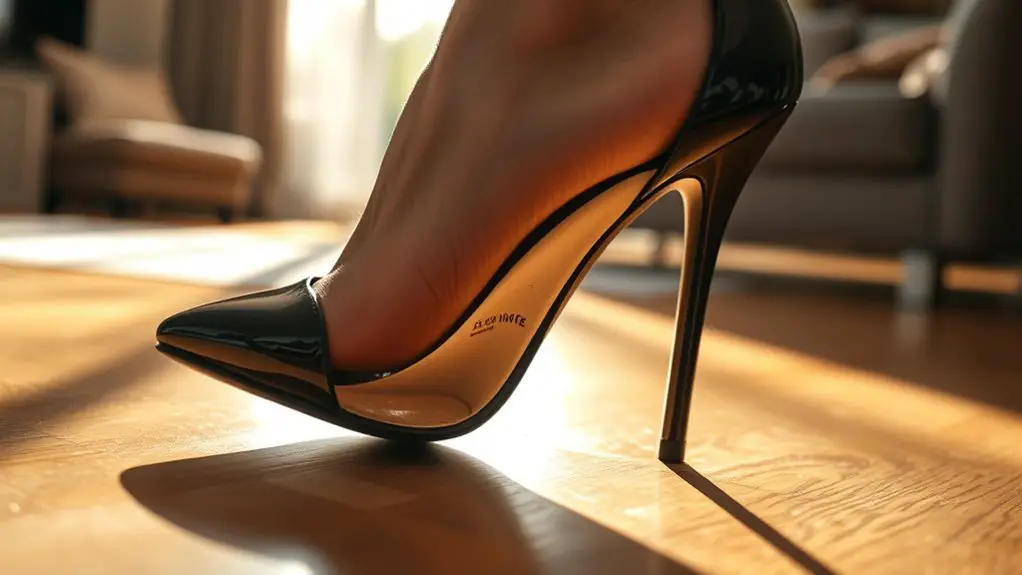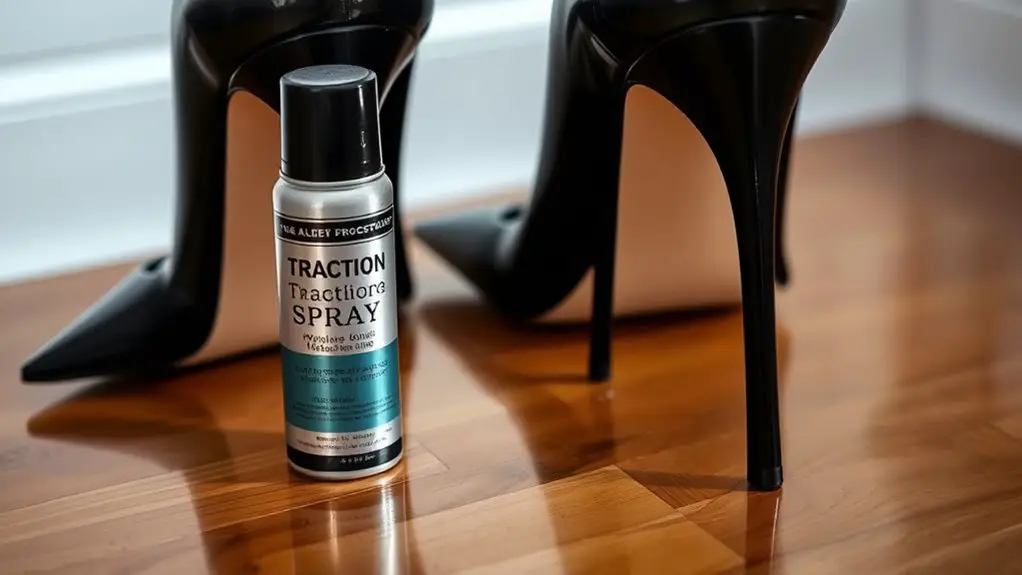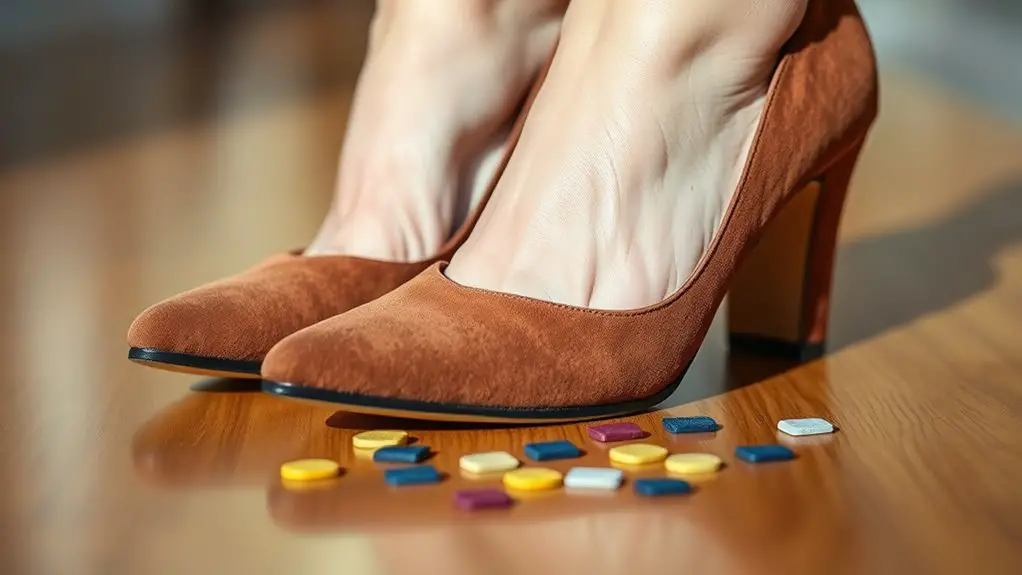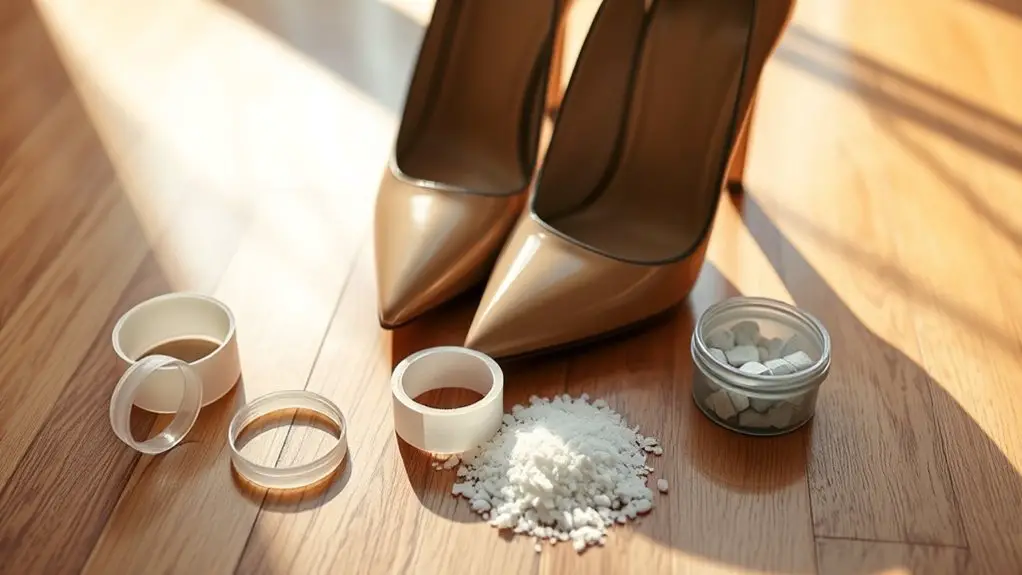To make your heels less slippery, try using non-slip sole inserts for better grip and comfort. Applying sandpaper to the soles can create a textured surface that enhances traction. You can also use traction spray for a quick, long-lasting solution. Wearing anti-slip heel grips adds cushioning and prevents slipping inside the shoe. Choose the right material for your heels, and keep them clean and dry for maximum safety. There are even more tips to guarantee your heels stay secure!
Use Non-Slip Sole Inserts

When it comes to conquering slippery heels, non-slip sole inserts can be your secret weapon. These handy additions not only enhance your grip but also provide a layer of comfort. Imagine walking confidently, knowing you won’t slip at that vital moment. Non-slip options come in various materials, like rubber or silicone, designed to improve traction without compromising style.
Sole durability is just as important. High-quality inserts can withstand wear and tear, ensuring they last through multiple outings. You’ll appreciate the extra support, especially during long events where you’re on your feet. Plus, they’re easy to apply—just peel and stick, and you’re ready to strut your stuff.
With non-slip sole inserts, you can tackle any surface with confidence, transforming your favorite heels into reliable companions. So, why let slippery soles dictate your style? Upgrade your footwear game today!
Apply Sandpaper to the Soles
If your heels are feeling a bit too slippery, sandpaper can be a game changer. By choosing the right grit and sanding evenly across the soles, you can create a textured surface that grips better on various floors. It’s a simple yet effective hack that can help you strut with confidence.
Choose the Right Grit
Choosing the right grit of sandpaper can make all the difference in enhancing the traction of your heels. When it comes to grit selection, you’ll want to be strategic to guarantee effective shoe care. Here’s a quick guide to help you choose:
- Coarse Grit (40-60 grit): Best for heavily worn soles, providing maximum traction.
- Medium Grit (80-120 grit): Ideal for smoothing out rough patches while still improving grip.
- Fine Grit (150-220 grit): Perfect for a polished finish, offering subtle traction without damaging your heels.
- Ultra-Fine Grit (240+ grit): Great for delicate materials, ensuring you maintain the integrity of your stylish shoes.
Sand Evenly Across Soles
Sanding evenly across the soles of your heels is essential for enhancing grip and preventing slips. Using proper sanding techniques, you can transform slick soles into safer surfaces. Start by choosing a fine-grit sandpaper, which will help create a textured finish without damaging the material. Gently rub the sandpaper against the sole in circular motions, ensuring even coverage. Focus on high-contact areas, like the ball and heel, where traction is vital. Regular sole maintenance not only improves grip but also extends the life of your favorite heels. After sanding, wipe away any dust to reveal the new texture, and you’ll feel confident strutting your stuff, knowing your heels are less slippery and more secure.
Try Traction Spray

One effective way to enhance the grip of your heels is by using traction spray. This handy product provides a quick solution for slippery soles, ensuring you walk confidently without the risk of slipping. Here are some traction spray benefits and application techniques you should consider:
Enhance your heel grip with traction spray for confident, slip-free walking in style.
- Improved Grip: Traction sprays create a textured surface, increasing friction between your shoes and the floor.
- Easy to Apply: Just spray evenly on the soles and let it dry for a few minutes before wearing your heels.
- Versatile Use: You can use it on various types of footwear, from stilettos to boots, providing all-around safety.
- Long-lasting Effect: Many traction sprays offer durability, ensuring your shoes stay grippy for multiple outings.
With these tips, you can make your heels safer and enjoy your stylish look without the worry of slippery mishaps!
Wear Anti-Slip Heel Grips
When you want to add an extra layer of security to your heels, wearing anti-slip heel grips can make all the difference. These small, adhesive pads are designed to enhance grip and prevent slipping, ensuring you walk confidently on various surfaces. The moment you apply them, you’ll notice a significant boost in heel comfort, as they provide cushioning that molds to your foot’s shape.
Anti-slip heel grips act as an invisible barrier between your foot and the shoe, reducing the chances of your foot sliding around. This grip enhancement not only minimizes the risk of falls but also helps you maintain a polished look, preventing those awkward moments when you feel unstable. Plus, they’re easy to apply and can be removed without damaging your shoes. With this simple addition, you can focus on enjoying your day, knowing your heels won’t betray you!
Choose the Right Material

When choosing heels, the material can make all the difference in how slippery they feel. Leather often provides better grip compared to synthetic materials, while a textured surface can enhance stability. Don’t forget to take into account the sole material too, as it plays an essential role in traction and comfort.
Leather vs. Synthetic Materials
Choosing the right material for your heels can make all the difference in comfort and stability, especially when you’re maneuvering slippery surfaces. You’ll often find yourself torn between leather and synthetic options. Here’s a quick comparison to help you decide:
- Leather Durability: Leather offers long-lasting wear, making it a solid investment for your wardrobe.
- Synthetic Flexibility: Synthetic materials provide more flexibility, allowing for a snug fit that molds to your foot.
- Breathability: Leather is generally more breathable, keeping your feet comfortable during long wear.
- Cost-Effectiveness: Synthetic options are often more affordable, allowing you to experiment with styles without breaking the bank.
Texture and Grip Factors
While the allure of high heels can be undeniable, the right texture and grip can make or break your experience. When choosing your heels, pay attention to texture types—smooth surfaces may look chic but often lack traction. Instead, opt for materials with a bit of texture, like suede or rubberized finishes, which provide better grip.
Additionally, consider grip patterns on the sole. A well-defined tread can greatly enhance stability, especially on slippery surfaces. Look for designs that incorporate both horizontal and vertical lines, as they can help channel water away, reducing slippage. By selecting heels with the right texture and grip patterns, you’ll not only feel more secure but also exude confidence as you strut your stuff.
Sole Material Options
The right sole material can greatly impact your comfort and stability in heels. When choosing heels, consider these sole options that enhance both sole durability and traction performance:
- Rubber: Offers excellent grip and shock absorption, perfect for maneuvering slick surfaces.
- Leather: Provides a classic look with decent traction, but may require adding a textured layer for better grip.
- Synthetic: Often lightweight and flexible, these soles can be designed for peak traction, making them a versatile choice.
- TPU (Thermoplastic Polyurethane): Known for its durability and slip resistance, this material combines comfort with stability.
Choosing the right sole material not only elevates your style but guarantees you walk with confidence, no matter the occasion.
Keep Your Heels Clean and Dry
Although it might seem tedious, keeping your heels clean and dry is essential for maintaining their grip and preventing slips. Regularly using effective cleaning techniques, like a damp cloth or a soft brush, can help remove dirt and grime that accumulates on the soles. For stubborn stains, a gentle soap solution is your best bet—just make sure to rinse thoroughly.
Once you’ve cleaned your heels, proper drying methods are vital. Avoid direct sunlight or heat sources, as they can warp the material. Instead, let your heels air dry in a cool, shaded area. You can also stuff them with newspaper to absorb moisture and maintain their shape.
Frequently Asked Questions
Can I Use Regular Glue to Create Traction on My Heels?
While regular glue might seem tempting, it’s not a wise choice for traction. Instead, explore dedicated heel grip alternatives. For effective shoe maintenance tips, consider using adhesive pads designed specifically for enhancing grip on slippery surfaces.
How Often Should I Replace My Non-Slip Sole Inserts?
You should replace your non-slip sole inserts every six months, depending on their durability and usage. Regular checks for wear can help maintain traction, ensuring you stay stable and stylish on your heels.
Will Traction Spray Damage My Shoe Material?
While you might worry about traction spray damaging your shoes, its effectiveness often hinges on shoe material compatibility. Testing a small area first can help guarantee your footwear remains stylish and functional without unwanted damage.
Are There Any DIY Methods for Anti-Slip Solutions?
If you’re looking for DIY grip solutions, you might try homemade traction pads made from rubber or adhesive tape. These can create a secure grip, making your heels safer and more comfortable to walk in.
Can I Wear Heels Safely on Wet Surfaces?
Maneuvering wet surfaces in heels can feel like dancing on ice. For wet surface safety, you can try heel grip techniques, like using rubber soles or adhesive pads, ensuring you stay steady and stylish despite slippery conditions.



